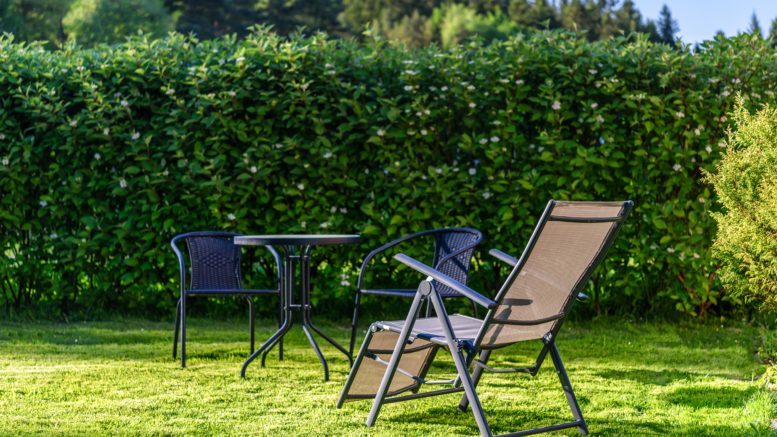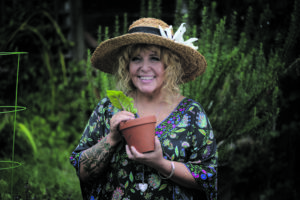If you can’t stand living with that heat reflecting metal panel fence, the windows of your neighbours blinking into your home or the view of the local shops, then screening plants are here to save the day.
Some can even make alternatives to fences, and all will cool down your garden, provide a wind break and enrich your home in some way as well as giving you privacy.
What’s the difference between a hedge and a screen?
Hedges are dense and completely block out the view while screens break up the view.
Screening growth lets airflow and dappled light through, and they can often look a little more natural.
Privacy screening growth is somewhere in between.
It will block the view to provide privacy, but will still be a little looser in growth than hedges to allow some airflow and light in.
Types of Plants
Evergreen trees and shrubs are going to be the choice for many as they provide year-round screening and although any plant could be trained to become a screen, including well trained vines, here are a few I recommend.
Mock Orange aka Orange Jessamine (Murraya paniculata) is one of the most popular hedging and screening plants. With its divine orange/jasmine perfumed flowers along with glossy green foliage it’s easy to see why. They can reach up to four meters in height and require a spacing of between 75 to 100cm to create a screening effect. They need regular feeding, a very well-drained rich soil and do prefer part-shade.
Viburnums are not known as ‘the hedges friend’ for nothing! They grow incredibly quickly and so can do the job of providing a screen fast and without the garden intrusiveness issues something like bamboo can pose. There are many varieties of this plant, and each have varying needs, so look for one that suits your light and soil position.
Personally, I have a Sweet Viburnum (Viburnum odoratissimum) screen along one of my front fences, planted to make the area a little more private from the street. Sweet Viburnum likes full sun to part shade, moderately rich and very well-drained soil and loves to be well-mulched, kept watered but not overly wet. It will grow up to nine meters in height and in ultra-fast time but pruning to keep it in check.
Bottle Brush (Callistemon spp.) is often overlooked as a screening plant and one I am currently cultivating in another area of my garden. Not only do you end up with a hardy, beautiful looking native screen but also gorgeous flowers for you and the native birds and bees! There are many varieties that grow in all sorts of shapes and sizes and have lots of different foliage and leaves.
Have a chat to a friendly local nursery person to find one to suit you.
Vicki of Narara Valley Nursey agreed, and I asked her for other suggestions.
She said, “Hands down I think Lily Pilly (Syzygium smithii) is one of the best choices as well as it is a native, fast growing and you get edible berries from most types.”
She said that they can get to an impressive five metres in height so are perfect to block out that towering thing you no longer want to see but smaller varieties are available as well.
Spacing to create a screen should be around 75cm and they like a very free-draining, rich spoil structure that is kept moist.
“There are so many varieties and look out for psyllids resistant types because that can be a problem in your area” she advised.
Planting and Growing Tips
Get your spacing right to begin with.
Roots can easily overcrowd and contribute to disease or death of your plants in a too closely planted screen or create a dense hedge that may not suit you.
Too far apart may not afford the look or privacy that you are after.
Don’t just use the recommended spacing on the plant label, check the recommended spacing for planting a privacy screen using that plant.
Scale is important to the overall look of your garden so think of the final size of your screen.
Large and high screens/hedges look better with larger leaves while more compact ones suit smaller leaves.
Prune and trim your screen regularly to encourage and maintain the shape you are looking for and when you do, make sure you feed your plants as you are reducing their available food-making structure.
Water as suggested for your plants and reduce as they attain full size.
TIME TO GET YOUR HANDS DIRTY
Everyone seems to love Hydrangeas and now is a good time to take hardwood cuttings. Still time to transplant deciduous trees and shrubs as well and watch out for the caterpillars of any cabbage moths that may be around. You could plant artichokes, asparagus crowns, broad beans, broccoli, cress, cabbage, carrot, English spinach, kale, kohlrabi, lettuce, mid and late season onion`s, parsnip, peas, radish, rhubarb crowns, shallot bulbs, snow peas, spring onion, turnip, English daisy, candytuft, Canterbury bells, delphinium, dianthus. forget-me-nots, lobelia, gypsophila, honesty, lupin, nemesia, nigella, pansy, poppy, snapdragon, statice, stock, sweet pea.
PLANT HAPPENINGS AROUND THE COAST THIS WEEK
Long Jetty Produce Swap, 10am – 11am Saturday 5th June Tuggerah Lakes – Branch of CWA NSW
Share excess organic edible produce from your garden: veggies, fruit, plants, flowers, cuttings, seeds, eggs, honey, homemade pickles and jams. Come together with minded locals and make some new friends.
Native Bee Hotel Workshop & Native Plants Giveaway, Pearl Beach Arboretum, 10am Saturday 12th June.
In conjunction with the Ephemeral Art trail, Franscisco Garcia Bulle Buenowill be conducting a workshop on how to set up Solitary Bee Hotels to be used in the Arboretum. Koala and bee attracting plants will be given away to the community (one per household). pearlbeacharboretum.org.au for details.
The 2021 Central Coast Harvest Festival Program See what’s on, plan your weekend (12th – 13th June). The program is now available online at: info.centralcoast.nsw.gov.au/harvestfestival
DOWN IN YOUR GARDEN
This week I visited the San Remo Community Garden after an invitation from Helen, one of the locals who loves being a part of her community garden.
Chairman Andy took me on his famous San Remo Community Garden tour, and we chatted about what it’s like to garden as a community gardener and generally on the Coast.
Established in 2005 after identifying a parcel of unused council land, the community worked hard to make their dream a reality and what a vision it is!
I’m greeted by a large block of neat though artfully arranged beds crafted from old boats, bathtubs, sinks and recycled building materials.
A huge patio and shed provide year-round protection for the gardeners who right now are chatting, laughing and plant planning over the whistling kettle.
Andy tells me, “The plants are really secondary. The way we like this garden to be is a peaceful and joyous place to come to and you don’t have to garden, you can just sit with us, have a yarn, a cup of tea and a bit of cake.”
A living wall of bromelias with artwork poked into any available space would be happy in Picasso’s Garden and statues of every conceivable type created from rescued materials delight me at every turn through the pathways.
San Remo Community Garden, 3 McCrea Blvd, San Remo, is open, free to the public Tuesdays and Thursdays 9am to 12pm and everyone is welcome. Facebook: San Remo Community Garden.
Andy answers my Three Big Gardening Questions
Q: One Plant You Can’t Live Without:
A: Globe Artichoke flowers he thinks are magnificent. They are his favourites.
Q: A Piece of Advice:
A: Find out where your sun is in the garden, don’t rush into things and keep a good sharp hoe.
Q: What Do you Think Your Garden Is Missing:
A: An entertainment area as he would love live music at the garden.
Cheralyn Darcey is a gardening author, community garden coordinator and along with Pete Little, hosts ‘At Home with The Gardening Gang’ 8 – 10am every Saturday on Coast FM 96.3.
Contact Cheralyn gardeningcentralcoast@gmail.com with your questions, events, news or if would like to be a part of ‘DOWN IN YOUR GARDEN’.




